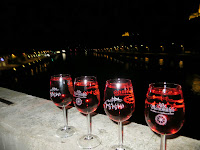A funny thing happened on the way. Blanche, my overworked GPS, was on her best behavior. We were pleasantly rolling along on major highways when we decided to top off our gas tank. I redirected Blanche to the nearest gas station, which she claimed was less than 5-km from where we were. We pulled off onto an exit for a small village and continued following Blanche, marveling over the beautiful landscape of the town as we passed vineyards and drove alongside a river.
When we were less than 1.5-km from the gas station, Blanche's voice suddenly went from confident to questioning as she proclaimed, "Drive 500-meters, then board ferry?!" And I'm not kidding; that's exactly the way she said it: "Board ferry?!" Evidently, the gas station was on the other side of the river and even Blanche thought it was odd that we would postpone our road trip for at least 20 minutes in order to board a ferry, ride the ferry, de-board, fill up on gas, and then repeat the process.
Needless to say, we decided to forego the ferry-boarding and found our way back to the highway (with Blanche's eager assistance).
 |
| Cochem |
Arriving in Cochem was very scenic. We crossed a bridge over the Mosel River, trailed by bicyclists and pedestrians who meandered along languidly. The cafes were filled as revelers clinked wine glasses and laughed gaily. Rising above it all was the imposing and beautiful Cochem Castle.
 |
| Cochem Castle above Vineyards |
It was described to us by the winemakers as a very young wine that is still fermenting. You can drink it right away or store it for a couple of weeks, during which time the fermentation process will continue and the wine will gain more alcohol content. It was very refreshing and light, as to be expected. The taste was sweet but more like a sweet fruit juice rather than a sweet wine (like Riesling). We immediately fell in love and bought a half-liter for three Euros. It's the perfect brunch beverage.
We soon learned we didn't have to be so quick to purchase in Nuremberg; Federweiss was everywhere in Cochem! Little tastes were offered on almost every corner for 50-cents and each one tasted a little different. It was lots of fun sampling and comparing. Federweiss is only around during the autumn harvest so I'm glad we were in the Mosel region (by chance) this time of year.
 |
| Delftware Fireplace |
 |
| Knights' Hall |
A tour of the castle lasts about 45 minutes. It's all in German but we were given an English guidebook to follow. We wandered through grand rooms beginning with the Dining Hall and ending with the Weapons Room. The castle is filled with treasures such as a fireplace decorated by Delftware, 16th-century furniture, and a painting of a Greek goddess.
My favorite room was the "Room Above the Last Gate." In this room hangs a mermaid chandelier. It's a symbolic figure to keep evil out of the castle. The guide suggested all of us touch the bottom of it for luck. One exits the room via a spiral staircase that winds the wrong way. This was to prevent any aggressors coming up the staircase from using their sword (carried in the right hand) to any great effect.
 |
| Mermaid Chandelier |
Outside we saw the old well, which is 150-ft deep. The Witch's Tower is the final landmark of the tour. The round tower survived the destruction of 1689. There are remnants of red paints beneath one of the windows, leading researchers to believe that the castle in the Middle Ages must have been very colorful. A huge mosaic representing St. Christopher adorns the west side of the main tower.
 |
| Well |
 |
| Witch's Tower |
After our tour, we walked back down to the village, passing through vineyards and strolling by half-timbered houses. From our bird's eye view at the castle, we noticed a chair lift in the distance. We found the entrance to the Cochemer Sesselbahn quickly. Having only "skied" once in my life (it's in quotations because my attempt was a complete failure; I'm from Florida!!), I've never been on an actual chair lift. I was a little nervous because the safety bars seemed awfully flimsy and I was the kid who was scared on the ferris wheel at the county fair every year. But I faced my fears and I'm glad I did. The ride was peaceful and we were able to have Federweiss one more time at the cafe at the top!
 |
| Cochemer Sesselbahn |
 |
| Cochem Castle from Sesselbahn |
Cochem is a delightful little village, definitely worth a stopover if you're ever in the Mosel Valley. If I were you, I'd try to make the trip during the fall season when the leaves are just beginning to turn, the days are becoming shorter, the smell of smoke from cozy fireplaces fills the air, and Federweiss is practically being given away everywhere you turn. Seriously, go for the Federweiss. And visit the castle, too.





















